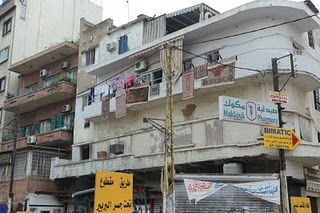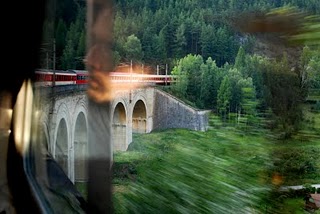First Time in the Middle East
 Friday, December 25, 2009 at 6:22AM
Friday, December 25, 2009 at 6:22AM Brad and I just returned from Jordan and Lebanon. It is now our tradition to travel to other countries before we visit our folks for Christmas. This year, we spent a week in the Middle East. I hope this blog will give you some insight and get you excited about visiting the beautiful Middle East. Here are all the photos, ordered chronologically. Please look at them as you read this blog.
The route
We flew from San Francisco to Amman (Jordan), visited the ancient Petra, then flew from Amman to Beirut (Lebanon), visited Beirut, and then flew back from Beirut to Vienna (via Amman), ending up in Slovakia for Christmas.
Airports
We visited two airports: Queen Alia International Airport in Amman and Beirut Rafic Hariri International Airport. These two airports deserve their own blog post as what we saw was pretty interesting. In Amman, for instance, the bus that drives the passengers from the airplane to the terminal actually *crosses* the runway. There is a big light, which needs to turn green before a bus can proceed straight across the runway. Even if the light is green, the traffic on the main road takes the precedence, so the bus has to wait until there is an opportunity to proceed. We spent about 5 minutes waiting for a gap between a bunch of airport cars. Some passengers were getting mad, worried they would miss their connecting flights, some were laughing in disbelief, one lady was cursing like a sailor. On our way back from Beirut, we flew through Amman airport again, this time as a transfer passengers. The information monitor was flashing "last call", so we were really hurrying to catch our connection. When we arrived at the gate, the airplane was not even there yet. The plane was 45 minutes delayed, and their information monitors were not updated at all. When people kept asking where is the airplane, wondering why the monitor says that the plane is boarding, the airport employee walked to the monitor that was right over the gate, grabbed a mouse, escaped from the full screen mode into a Microsoft Powerpoint presentation (wow), updated the boarding time, and set the PowerPoint back to the full screen mode. Coming from Silicon Valley, this was quite amusing to us. We were quite thankful that the airplane we flew was not made in Jordan.
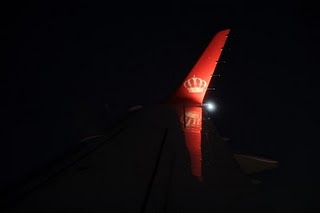
The passport control employee was asking for another ID from me. I said I only had my passport, and then he asked for another passport. I said I have only one. He then let me go. It was really weird.
The luggage screener at the Beirut airport asked me to open my bag. I did, and then he moved things around my bag, searching for something he saw in the X-ray. He was very disrespectful towards me, starred at me and Brad, looked and talked to us in a condescending way, and did not handle my personal belongings gently. He damaged one of my souvenirs. Brad was consoling me later, since I was extremely disturbed. I know that airport employees do not handle luggage the way passengers would want them to, but doing this in front of my eyes, and giving us rude stare really made me appreciate the level of service we get at the US airports. However, not all employees were rude. The check-in lady was very helpful and friendly.
In contrast with the US, when going through the security, we did not have to take off our shoes, or take out the liquids, and throw away our drinks. We took our water bottles with us. But all ladies have to walk to the side and go behind a privacy screen where a female employee does the security check.
Airplanes
We used Royal Jordanian for all 4 flights from/to and within the Middle East. Their planes are new and clean, have superior TV monitors with a wide array of movies to watch. The food was also very good (well, for an airplane).
Jordan
Sayel made us feel very welcome, and he stopped by few places on our way to Petra to show us points of interest, such as an Ottoman village, or a castle ruin. He wanted to invite us home for a lunch, but we did not have enough time on our hands, so we promised to visit his family next time. If you would like to hire Sayel, please email me and I will give you his email.
Hotel in Petra
Hotel lobbies, army bases, store fronts, tourist sites, people's home -- they all have photos of King Abdullah II, who is very popular in Jordan. He wears an army uniform in the photos displayed at the army base, and he wears a suit and a tie in the photos displayed in the hotel.
Petra Park
For 26 JD you get a 2-day pass with multiple re-entry (Jordanians pay only 1 JD). As soon as you enter the park, lots of Bedouins and children start offering you horse, camel, or donkey rides, rocks and various made-in-china trinkets for sale. If you are an attractive lady, Jordanian men will wink at you a lot. Even the police officers. I found it quite amusing.
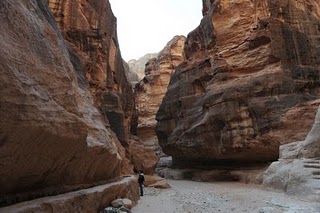
After the walk via the narrow Siq, you enter a sand plaza with the famous Petra Treasury. If you take a right, and continue via another short canyon lined with tombs, you get to an open area with a large Roman amphitheatre on the left, and a number of majestic tombs on both sides. Another 10 minutes would be needed to pass by an array of the remains of Roman columns and reach the restaurant called The Basin (by Crowne Plaza).
If you are tired by now, you need to turn around and go back, uphill all the way to the park entrance. We had some energy left, so we decided to spend another 2 hours (1 hour walk up, 1 hour walk down) and hike up to the Monastery. The path from The Basin restaurant to the Monastery is quite a hike. Of course, you will get many opportunities to rent a donkey, or buy some made-in-china trinkets on the way up. The Monastery looks very similar to the Treasury, but the best part of the hike are the views of the canyons you see while hiking up. We brought a thermos with a tea, which came handy.
When we got back to the hotel, a tray of yummy sweet treats (baklava and dates) was waiting in our room. We could not feel our calves. If you plan to spend another day hiking other parts of Petra park, make sure to get in shape before you come to Jordan. You can see the most important parts of Petra in 3 hours (add 2 hours for the Monastery). But you can spend days hiking and exploring the trails within the park.
What else to see
We did not visit the Dead Sea, but will definitely go float in it next time. I asked Sayel if anyone ever drowned in this sea, and he said that a Russian man got drunk and drowned in it about 2 years ago. Pretty sad.
Sayel often takes foreigners to a 6 to 15 day trips via Jordan, Syria, and Lebanon. Amman is only 6 hours car ride away from Beirut, so we might just drive next time.
Beirut taxis
After 2 days and one night in Petra, Sayel took us back to Amman airport and we flew to Beirut. Beirut was nothing like I expected. It is full of contrasts and surprises. As soon as we landed in Beirut, a local taxi driver kept following us at airport hall, offering us a ride to our hotel. We ignored him, but he kept getting more and more aggressive, grabbing our bags, and insisting that we go with him. Brad was OK with that but I was not. The dude looked shady, and when we got to his car, I got even more worried. The car did not have a taxi sign on, it was an old beaten sedan, and he was unable to fit our luggage into the trunk. Airport employees were laughing at me, saying that the guy is legit. I pretty much freaked out, took my bag, and walked away. Brad took his bag and joined me, saying that he will help me find a well marked taxi. The taxi driver followed us, unhappy, showing us his license, and saying that we have no reason to worry. I kept going until I found a clean new car, with a big "taxi" on it, which we took to our hotel. It cost us $40. (The ride back cost us only $25.) You can pay with USD pretty much anywhere in Lebanon. It is their other official currency, and even ATMs always give you a choice of the currency when withdrawing money. Same in the stores, they always ask "dollars or Lebanese?".
When we arrived to a hotel (Holiday Inn Dunes), I was happy that the whole taxi stress was over. We looked up some facts about Lebanese taxis, and found out that taxis in Beirut do not have meters, are often not marked, but always have red license plates, and if you take one within the city, you pay from 8,000 to 12,000 Lebanese Pounds ($5 - $8), depending on the traffic and the shape the taxi is in. If the driver recognizes that you are a tourist, he/she will try to ask for 20,000 LBP. In that case, you just give him/her a 10,000 bill and walk away. The Wikipedia recommended that when entering a taxi, you should say "bonjour", which might lower your chances of getting ripped off. French is a second official language (Lebanon was colonized by French), and locals like to think of themselves as almost European. They keep reiterating that they are not Arab. They have separate ancestral origins, but because Lebanon went through a strong Arabization, Lebanese people are often referred to as Arabs... and they hate it.
Beirut City walk
The air quality is the worst of all cities I have ever visited. It appears that there is no emission standard in place, so walking on the waterfront was a little escape from the fume filled streets of Beirut.


We then walked little bit uphill towards a weird looking war-damaged round building. We later found out that it is a former theatre, and will be remodelled soon.
Ksara and Baalbek (Lebanon)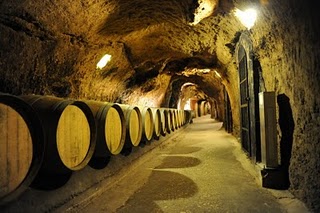
We visited the famous Ksara winery, and were toured via its underground catacombs, that now hold 700,000 bottles of wine. Brad then tasted few wines, and we continued our journey to the temple ruins of Baalbek. The site is huge, it is difficult to describe the scale of this site. If you are a Roman scholar, you would love this place.
On our way back from Baalbek, we almost got into a couple of accidents, since no one obeys traffic rules. We even saw a taxi driver drink Heineken while driving. :)
Food in Lebanon
I gained some extra pounds in the 4 days we spent in Lebanon. We ate Lebanese food for the first three days, up to the point when we could not even see it. Our favorite restaurant was right in Beirut downtown, called Karam. We ordered food for six people (eight dishes), plus drinks and a water pipe, and paid only $60. When we asked for a check, the waiter asked why don't we stay longer. People did seem to come and stay there for hours.
The service in Beirut is pretty slow, and getting a coffee and a small sandwich in a mall (ABC Beirut) took over 45 minutes. Again, we now appreciate the San Francisco Bay Area a lot more.
The first day in Beirut, we walked to a restaurant Beity, which is one block walk from the Holiday Inn Dunes. There was some kind of party there, we could not figure out if it was a wedding or an engagement party. People danced to modern Lebanese tunes, and we watched them while eating our food.
Malls in Beirut
When entering a mall, you might be asked to show your bag, show that you are not carrying a bomb. I was also asked not to take a photograph of a Christmas tree in a mall.
To my disappointment, the malls are identical to any US malls. We visited Dunes mall, ABC mall, and also a brad new mall (still unfinished) that is one block downhill from the downtown clock tower. We also passed by some local stores when walking from ABC mall back to downtown, but we did not see anything breathtaking to buy. My dreams of Georges Hobeika dresses did not get fulfilled.
Right before leaving Beirut, we walked by a Al Bohsali Patisserie Orientale, and bought 0.5 kg of fresh made baklava. It was a nice sweet end to our trip.

